11.5 Recovering deleted mailboxes
|
| < Day Day Up > |
|
Administrators make mistakes from time to time, and one of the most common mistakes is deleting a mailbox in error. The Exchange 2003 Mailbox Recovery Center makes it easier for administrators to fix the problem and restore service to users of deleted mailboxes. Unlike Exchange 2000, the Mailbox Recovery Center (MRC) permits centralized management and recovery of deleted mailboxes.
If an administrator deletes a mailbox on an Exchange 4.0-5.5 server, he or she has to restore the Mailbox Store on a recovery server to retrieve the mailbox and export its contents to a PST, and then import the contents back into a newly created mailbox. The process is easier for Exchange 2000, because administrators can set a retention period (the default period is 30 days) for deleted mailboxes as a Mailbox Store property. Thereafter, Exchange hides any deleted mailboxes and keeps their contents in their original Mailbox Store until the deletion period expires, at which time the Store deletes the mailbox content. This mechanism is possible because mailboxes exist within the database, and the link between users and mailboxes comes from attributes applied to mail-enabled AD user objects. When you delete a user mailbox, the effect is to clear the attributes so the user object is no longer mail enabled. As long as you do not delete the user object and Exchange has not cleared the mailbox contents upon expiration of the deletion period, you always have the opportunity to reestablish the link between the mailbox and the user.
To recover a deleted Exchange mailbox, you can browse the list of mailboxes in a Store and identify the deleted mailboxes, which the Store marks with a red icon (the marking is much more obvious in Exchange 2000- Exchange 2003 takes a more subtle approach). The Mailbox Cleanup Agent, which the System Attendant process runs nightly as part of normal background maintenance, is responsible for marking the deleted mailboxes. You can also force ESM to run the Mailbox Cleanup Agent by right-clicking on a Mailbox Store and selecting the option. After the agent finishes, refresh the mailbox list and you should see a display similar to that shown in Figure 11.25, where you can see three deleted mailboxes.
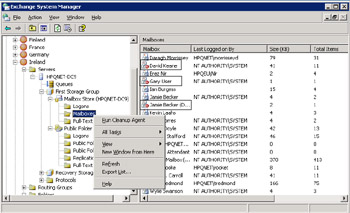
Figure 11.25: Viewing deleted mailboxes.
After you locate the mailbox that you want to recover, you right-click on the mailbox and select the "Reconnect" option (Figure 11.26). You can now browse the AD to select a user who does not currently have a mailbox. Click on OK, and Exchange connects the mailbox to the user by populating the necessary attributes for the user object. The next run of the Recipient Update Service for the domain then completes the process by ensuring that the newly connected user object has the proper email addresses. Note that if you find a disconnected mailbox that you absolutely do not want to keep, you can use the Purge option to remove it from the Store.
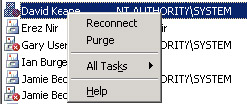
Figure 11.26: Reconnect a deleted mailbox.
All of this sounds perfectly logical and the process works, but it is intended for processing single mailboxes rather than centralized management. You can argue that this is the way that Exchange should perform mailbox recovery. After all, only a few such cases occur yearly in even the largest organization, and it is best for the administrator of the local server to handle the problem, but there are situations when you need to reconnect many mailboxes quickly, so it is good to be able to manage this process centrally. For example, in a disaster scenario, you may want to restore a database on a recovery server and then connect the mailboxes in the recovered Store to AD accounts to allow users to regain access to them. Microsoft provides the MBCONN[2] utility for this purpose, but MBCONN is not a supported part of the product, so some customers do not like to use it.
11.5.1 MRC: Mailbox Recovery Center
The Exchange 2003 MRC features are a new entry in the Tools section of ESM. In one way, you can think of the MRC as a souped-up version of MBCONN with a new UI that allows administrators to recover mailboxes from a central point, providing their accounts possess the necessary permissions to access the Stores that hold the deleted mailboxes.
You begin working with the MRC by identifying the Mailbox Stores that you want to work with. Open ESM and click on the MRC tool, then right-click and select "Add Mailbox Store." If you know the name of the Mailbox Store you want to work with, you can enter it now, or just type the first couple of characters in the Store name and click on "Find Now." ESM will then scan the AD to find all the Mailbox Stores that match and display a dialog to allow you to select Stores to work with, as shown in Figure 11.27. You can see that the names of all of the Stores listed start with "Mail-box," which is the default naming convention used by Exchange to name a new Store at creation.
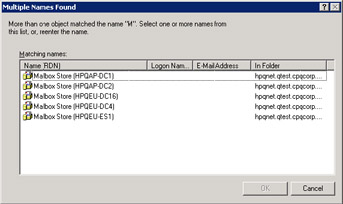
Figure 11.27: Viewing a list of Mailbox Stores.
If you are not quite sure about the Store you want to work with, click on the "Advanced" button to set search criteria. Figure 11.28 shows the result of browsing for all Stores that contain deleted mailboxes in an organization. After you select a Store, you see a list of deleted mailboxes. You can now select mailboxes and take three options:
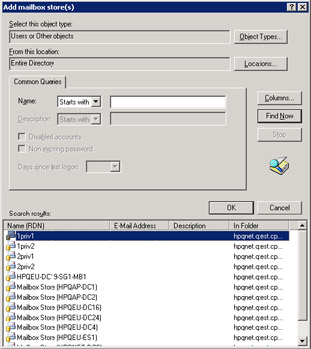
Figure 11.28: Finding a Mailbox Store.
-
Find Match: Scan the AD to find user accounts that match the mailboxes.
-
Resolve Conflicts: Resolve any conflicts that exist where you could connect multiple AD accounts to a mailbox.
-
Reconnect: Reestablish the link between a deleted mailbox and an AD account. You have to match a mailbox with an account before you can reconnect.
Figure 11.29 shows ESM with a list of deleted accounts. The image in the bottom right-hand side of the screen shows the options, and you can also see the result of finding a match for Todd Rooke's mailbox because the user name column is populated with the DN for the AD account that ESM has matched the mailbox with. After matching the mailboxes, you complete the recovery process with the "Reconnect" option. You can connect a mailbox to an AD account different from that used previously if you need to. Upon successful completion, the user should be able to log on to his or her mailbox again. Note that once you establish a context for the MRC, you can use the refresh option to request ESM to examine the selected Stores and refresh the deleted mailboxes list. This action includes mailboxes deleted since the last listing and removes any reconnected mailboxes. The Mailbox Recovery Center builds on existing functionality to provide Exchange 2003 administrators with the ability to manage mailbox recovery on a centralized basis. While the feature might seem relatively unimportant, you will be glad it exists if you ever need to use it.
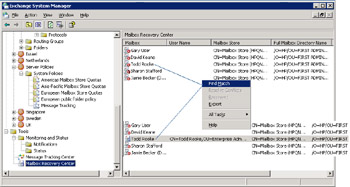
Figure 11.29: Viewing a list of deleted mailboxes.
[2] . See the \support\utils\i386 folder on the Exchange 2000 server CD. Apart from the MBCONN help file in the same location, you can find additional information about using MBCONN in Microsoft Knowledge Base article 271886. In some respects, you can think of MBCONN as being similar to the DS/IS consistency adjuster.
|
| < Day Day Up > |
|
EAN: 2147483647
Pages: 188